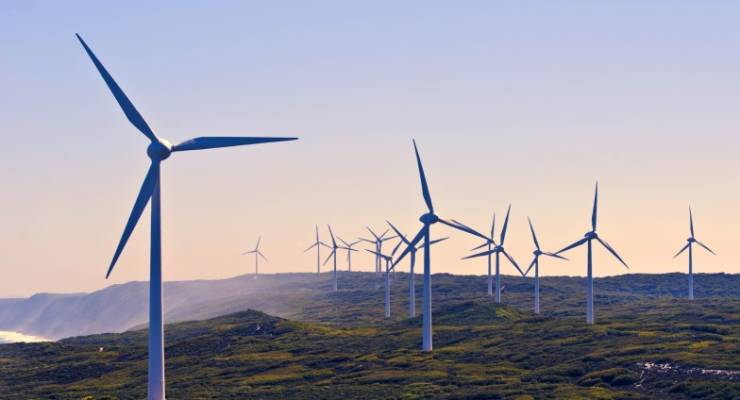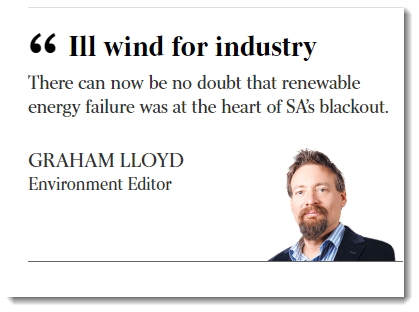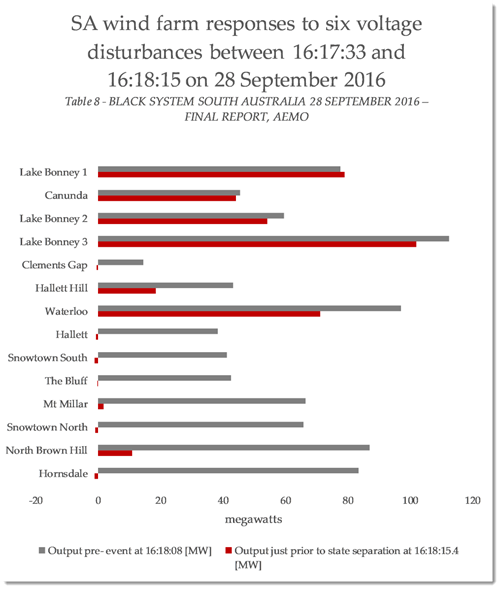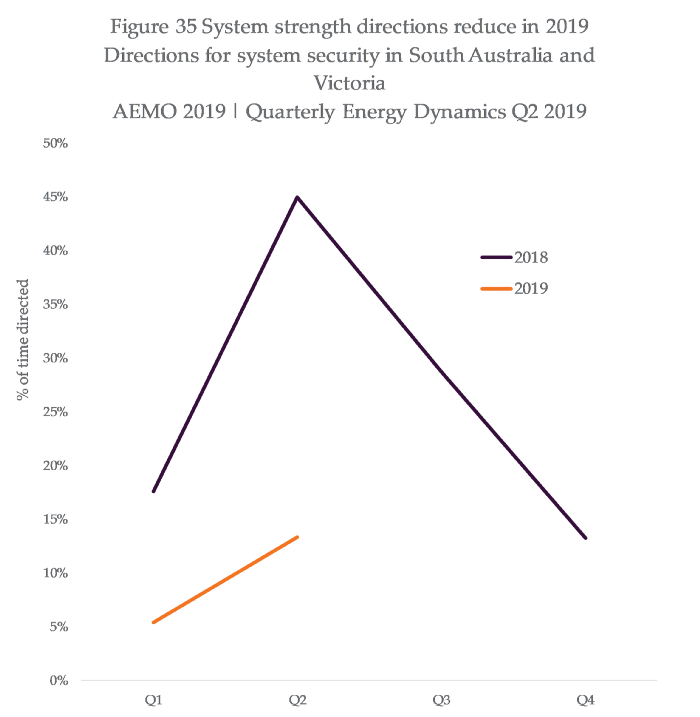
The Australian Energy Regulator has announced it’s suing four wind farm operators, alleging the software settings on their turbines resulted in those turbines tripping offline during a massive storm in September 2016. This sudden shutdown, caused by big voltage dips, resulted in an overloading of the interconnector which was trying to compensate for the sudden loss of power. The interconnector shut down, separating SA from the other states, and resulting in SA’s entire grid shutting down.
That paragraph is confusing. It’s a weird flurry of unfamiliar terminology. This confusion buries a very specific and simply understood trick of causality and consequence.
Since the blackout happened in 2016, the event has taken on a mystical significance among opponents of decarbonisation, deniers of climate change and proponents of fossil fuels. Presenting this event as irrefutable proof of the immediate and apocalyptic harm of decarbonisation is a long-running and significant project in Australia.
The goal here is seemingly to take a curable and temporary problem — a bunch of immediately-rectified variables in the software settings of a sub-set of turbines in South Australia — and turn it into an intractable, incurable, horrifying and unfixable apocalypse inherent to wind energy. This is only fixable, so the thinking goes, if we take roaring chainsaws to the base of wind turbine generators and erect belching smoke stacks between their metallic, ragged stumps.
Here’s an example, from Angus Taylor, experienced anti-wind farm campaigner and Australia’s current Energy and Emissions Reduction minister, on Sky News: “That generation needs to be properly integrated. It needs to perform, particularly in circumstances that are tough like we saw at the end of 2016 in South Australia. It also means that solar and wind need to be backed up appropriately so when the wind doesn’t blow and the sun doesn’t shine, customers know that when they flick the switch the lights come on.”
Graham Lloyd, environment editor at The Australian, parroted Taylor’s lines saying, “it has led to greater scrutiny of the amount of renewable energy that can be put into the electricity system without back-up”.

Did you see what happened there? One second, we were talking about numbers punched into a computer inside a wind turbine. The next second, we’re talking about how wind speed varies: a problem inherent to the resource it’s capturing.
“Renewable energy failure was at the heart of SA’s blackout” increases in mystical, spiritual power the more times you chant it.
Not every wind turbine in South Australia had these software problems. Four wind farms rode through through with minimal variations in output as a natural response to voltage fluctuations. Waterloo saw some variation due to a tool for managing voltage fluctuations called “active power management”. The remainder “have a protection system that takes action if the number of ride through events in a specific period exceeds a pre-set limit”.

Let’s be really explicit about this: the wind farms above didn’t shut down because the winds were too low, or because the winds were too high. They didn’t shut down because they’re machines born with a cruel, terrible curse.
So when Angus Taylor starts talking about the wind “not blowing” and the sun “not shining”, he’s referring to something completely different; he’s converting this rectifiable problem into a systemic, unfixable flaw.
Further, framing the South Australian blackout as punishment for the sin of decarbonisation started on the very night of the event, when Chris Uhlmann, then the ABC’s political editor, said this: “40% of South Australia’s power is wind-generated, and that has the problem of being intermittent — and what we understand at the moment is that those turbines aren’t turning because the wind is blowing too fast.”
This took the nature of wind power — that it varies according to wind — and applied that as the cause of the event (“turbines aren’t turning because the wind”). These moments are significant — a mad scramble to form reasons, in the literal immediate aftermath of the event, to figure out why wind power was to blame.
He tried again the next day, switching from “not enough power” to “too much”:
Wind power was simultaneously generating too much and nothing at all, just prior to yesterday's #SAStorms blackout o_O pic.twitter.com/NhK4Y5NsDN
— Ketan Joshi (@KetanJ0) September 29, 2016
Over time, Uhlmann’s statements changed shape. He claimed that wind farms only generate “30% of the time” — another statement based on a major misunderstanding of capacity factor. He then claimed that the frequency of wind turbines “fluctuates with the breeze” — which is also wrong.
Not only do most of these declarations remain on ABC websites, an ABC investigation into Uhlmann’s segment cleared him of any journalistic wrongdoing. “[He] neither stated nor implied that the blackout in South Australia occurred because of South Australia’s reliance on renewable energy”, they somehow formulated of that specific segment. This came with no reference to Uhlmann’s claim, on the previous night, that “turbines weren’t turning” due to insufficient wind.
Uhlmann now seems vindicated by the energy regulator’s decision to commence proceedings against the wind farms, despite the fact that it relates not to the characteristics of wind power, but to variables on specific turbines.
Uhlmann’s dual position — initially, that he was never blaming renewables (‘just asking questions!’ was the plea accepted by the media authority), but that he was also right to blame renewables, is a perfect example of how the facts change constantly to fit a pre-existing conclusion.
Of course, system strength, inertia and frequency control are important issues. Uhlmann touches on this, but confusingly seems to be insisting that SA would’ve stayed online if traditional thermal generators dominated its grid. There’s no way to know this without detailed modelling, but none has been done.
The political capital of the South Australian blackout is inexhaustible. It was revealed that the Chamber of Minerals and Energy, Western Australia, was linked to an army of fake Twitter accounts blaming renewables in SA for the blackout. The talisman became so powerful that Sky News’ Chris Kenny felt comfortable linking a plug falling out of a wall at an Adele concert with South Australia’s wholly manufactured “energy crisis”.
This is only the start of a massive re-prosecution of the firestorm that followed the 2016 blackout. Intentionally re-framing this issue as a problem with the “intermittency” of wind is serious business.
So, is South Australia currently being ravaged by blackouts? A report from the Australian Energy Markets Commission says, “These trends in supply interruptions have been relatively stable for the past 10 years. There have only been two instances of reliability interruptions, in 2008–09 where reliability interruptions accounted for 1.4% of total supply interruptions and 2016–17 (0.05% of total supply interruptions).”
This doesn’t mean there won’t be big challenges in the future with integrating renewable energy. But the raw reality of this phenomenon as a manufactured crisis — a big, single dramatic event that serves as a protected political species — is clear. Most blackouts still happen due to problems in local powerlines.
Uhlmann also complains of the number of times the Australian Energy Market Operator (AEMO) has to issue directions to generators in South Australia to preserve system strength (ordering coal and gas to stay online, or solar and wind to limit output): “South Australia’s power system is on life support, kept afloat by now routine interventions by the energy market operator”.
AEMO’s Q2 2019 energy dynamics report provides an update on these interventions:

Part of the reason for these decreases is seasonal, but the year-on-year differences suggest AEMO’s getting better at managing these directions.
Here’s the real kicker: in March 2017, there came a real, specific test of whether the problem that caused those seven wind farms to shut down had been properly resolved. A piece of kit in a transformer in Torrens, South Australia, literally exploded and 610 megawatts of gas-fired power suddenly disconnected.
From the AEMO: “All wind farms in SA successfully rode through a series of three transmission faults in short succession on March 3, indicating the changes made to their protection system since September 28 2016 have been successful”.
Again, no, this doesn’t mean that every challenge of integrating renewables has been solved. But the specific cause of this event as it relates to wind power has been demonstrably resolved. What more is there to say?
This is an edited version of a piece which originally appeared on Medium. Ketan Joshi is a science, technology and data communications professional.
How do you think this issue has been politicised? Write to boss@crikey.com.au and let us know.








The mis-interpretation & mis-reporting of the September 2016 blackout is scandalous. Had Uhlmann been a News Corp or Sky journo his piece would’ve been predictable but he was broadcasting under the ABC banner which normally demands a high standard of legitimate reporting.
There are intelligent people in SA who still believe the blackout was due to the shortcomings of renewables – purely because they read it so frequently in The Advertiser. South Australians have no alternative to Murdoch, just as in Qld the daily offering is swill.
Just showing the Commercials his colours; and now he is one.
Far be it for me to rush to the defence of an obviously unsuited Minister but
the recent London blackout was blamed in part on the vagaries of the wind
https://www.bloomberg.com/news/articles/2019-08-09/london-blackout-occurred-amid-drop-in-wind-and-natural-gas-power
John Kotsopoulos
Sent from my iPhone
Chris Uhlmann is still regarded by many of his ex colleagues on the ABC as a journalist of great intelligence and, especially, an expert on the operation of the NEM. His influence on many ABC listeners in SA have been quite malign through his uninformed opinions on the causes of the SA blackout.
The article blusters with empty virtue. The fact is that wind power is intermittent. Intermittent power is useless to the consumer unless it is backed up by greater fossil power, and the wind industry wants the rest of us to pay for it. After coal has gone, they want gas to stay. But gas must go too.
If decarbonisation is to proceed, the wind industry must provide its own backup and it must be carbon-free. Let them pump water into tanks on mile-high towers, or buy their own nuclear reactors if they must. But the rest of us should only pay them at a rate similar to that of other carbon-free generators on the grid.
The article points out that the problem that occurred in South Australia was nothing to do with intermittency.
A few turbine farms had a fault which stopped them operating, while many others did not have the fault and continued to operate.
I don’t know where you get the idea that wind power requires greater fossil fuel power to back it up, or that they want us to pay for it.
The point about keeping gas is to keep things stable during the transition period. Gas turbine power pants can quickly ramp up to meet demand, which is something that coal and nuclear power cannot.
Gas turbines emit significantly less CO2 than coal plants, particularly in combined cycle plants.
But they are needed until sufficient storage is built up, preferably decentralised.
The problem with a privatised electricity sector is that there is no long term plan. Private operators will build the system that will give them the best profit. Wind turbines are cheap and (relatively) easy to deploy. So that is where the money went.
There has been no coordination with storage solutions.
That is changing, with several companies proposing systems around Australia.
And AGL, which operates most of the gas power in South Australia, have wind farms and have announced plans to construct a pumped hydro project using a disused open cut mine for the lower reservoir (250MW/2,000MWh).
I have doubts that a nuclear plant, that you favour, would be complete and operating by the time the coal plants it would be replacing are closed. Even new coal plants must be in doubt for that timetable.
A wind farm has a capacity factor of about 30% and a system of separated windfarms does somewhat better. During the time it contributes to the grid, its intermittent shortfalls that comprise the 70% must be made up from elsewhere in the grid.
When there are few wind installations in a grid, all of the power demand is matched from steam driven generators. Any contribution from the wind is compensated by cutting back the load on the spinning generators, and any shortfall from the wind is made up by the steam generators resuming full power. That assumes there is much greater fossil generation in the grid than wind. In 2016, most of the backup for South Australian wind lay in the giant (coal-fired) steam generators in Victoria. The 1000 km of connection made SA vulnerable.
When more of the power in the grid is supplied by wind, the backup has to be more explicit, in the form of open cycle gas turbines. These are only 60 to 70% as efficient as a closed cycle gas generator, which includes a steam stage. However they can pick up the load from near zero to full load in a few minutes. (The gas saving implied by an extra wind turbine is similar to the gas lost by the inefficient extra gas turbine matching it.) After the 2016 blackout, SA Premier Jay Wetherall had an extra 250 MW gas turbine installed inside South Australia, providing a more robust backup to the SA wind system.
When wind saturates the grid, that is, when the peak production from wind supplies the entire grid demand, the 50-70% of its shortfalls must still be made up by backup. Much of that backup will be steam generated and in theory at least, storage. However when we decarbonise, that storage or steam cannot be provided by either coal or gas.
Full decarbonisation has to wait until massive storage has been invented, or until SMRs, mass-produced nuclear reactors are rolling off the production lines. Both solutions will require mass production worldwide, before decarbonisation can be effective.
SMR’s are a fantasy that exist only in the heads of nuclear protagonists. Bringing them to reality is likely to involve even more delays and cost over-runs than have recently been experienced by experienced nuclear nations (Britain, France, Germany, USA) building their new conventional nuclear plants.
“When wind saturates the grid, that is, when the peak production from wind supplies the entire grid demand, the 50-70% of its shortfalls must still be made up by backup. ”
Huh?
When peak production of wind power supplies the entire grid demand, where are the shortfalls?
When wind power exceeds grid requirements the excess is sent to storage.
“When [overbuilt] wind power exceeds grid requirements the excess is sent to storage”. That’s if there is such a thing as massive storage, but there is no feasible technology surviving scrutiny. The wind industry is vigorous and expanding fast, but they are making no visible attempts at establishing storage. They and their ideological friends promise us 100% renewable energy as long as somebody else takes the responsibility for the absence of storage. Instead of seeing feasibility studies into PHES etc, we find we are being blackmailed into providing them indefinitely with backup – another hundred years of gas infrastructure. Everywhere we are bombarded with propaganda against the enemies of gas (coal and nuclear) when we should be fielding strong arguments against the enemies of the greenhouse (coal and gas).
“Instead of seeing feasibility studies into PHES etc, we find we are being blackmailed into providing them indefinitely with backup”
“There are 22,000 possible sites for pumped hydro storage across Australia”
https://arena.gov.au/blog/andrew-blakers/
“The locations of these sites are shown below. Each site has between 1 gigawatt-hour (GWh) and 300GWh of storage potential. To put this in perspective, our earlier research showed that Australia needs just 450GWh of storage capacity (and 20GW of generation power) spread across a few dozen sites to support a 100% renewable electricity system.”
[The table of possible sites has a total capacity of 67,000GWh.]
“AGL plans 250MW pumped hydro plant in South Australia as replacement for gas”
https://reneweconomy.com.au/agl-plans-250mw-pumped-hydro-plant-in-south-australia-as-replacement-for-gas-17008/
““Future is storage:” SA govt pumps for four more hydro projects”
https://reneweconomy.com.au/future-is-storage-sa-govt-pumps-for-four-more-hydro-projects-41345/
“EnergyAustralia juggles legacy coal assets and new storage as transition accelerates”
https://reneweconomy.com.au/energyaustralia-juggles-legacy-coal-assets-and-new-storage-as-transition-accelerates-68292/
“EA is looking to make a “final Investment Decisions” [FID] on the Cultana seawater pumped hydro development in South Australia, it has a heads of agreement to write a PPA with publicly listed Genex in Queensland on Genex’s Kidston pumped hydro and solar farm in outback Northern Queensland. Genex has hopefully started preliminary work on the proposal.”
The last one negates one of the biggest criticisms of pumped hydro storage – access to water. There is plenty of sea water, after all.
And let’s not forget the Snowy Hydro 2.0 Scheme. 2,000MW and 350GWh (ie 175 hours of storage).
Any halfway competent engineer will tell you that this was a load of poppycock. The fallen pylons & transmission lines caused short circuits that tripped the overloads and burned out fuses in switchyards every where, in order to prevent damage to the power sources as applicable – AS DESIGNED! Was this inquisition manned by anyone else but lawyers? “Fail-safe” operation has to be built in as required by regulations based on common sense.
Yes indeed BG. I’m no engineer but I know enough about electrical systems to know you must have comprehensive safety, overload and short circuit protection. And that these considerations must override all others. Better a blackout than half the private electrical equipment in the state getting fried. How do you keep a grid running without interruption when several main lines have just been crunched ?
The disgrace of this is that this has somehow enhanced Uhlmann’s reputation rather than finishing off his credibility. Astounding.
And is there anything nuclear can’t apparently save us from ?
Is there anything nuclear can’t apparently save us from ? Not according to some of the diehards here. Windmills are now reaching 10MW capacity. Solar is becoming ever more efficient. Storage is still the main problem, but will be solved sooner rather than later. Pumped hydro on the other hand is a mature technology that has used worldwide for many years and could be rolled out Australia-wide in a short time (and no, Roger, we’re not talking about a tank on a mile high tower). I read that ANU has found 22,000 potential Australian sites. The cost of one nuclear plant would supply us with enough pumped hydro plants to satisfy projected needs and will do so well beyond the lifetime of the nuclear plant (and without the cleanup costs).
‘And is there anything nuclear can’t apparently save us from ?’
Ourselves.